What Are the Most Common Arts and Crafts Sioux Nations
As the first corking civilizations in the Americas, the Get-go Peoples comprised numerous cultures stretching from the far north of the Arctic to the southern tip of South America. While in that location exist many commonalities tying these diverse tribes to a common cultural heritage, contempo historical research has demonstrated stark differences between the traditions, art, and civilisation of these glorious tribes.
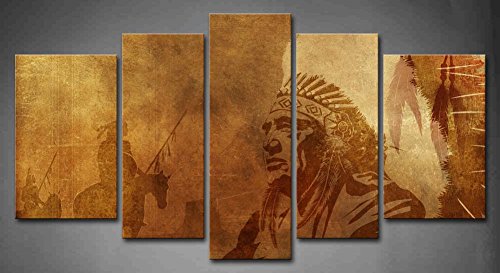
It would be impossible to try and showroom the contributions of each and every one of these peoples in a single commodity, which is why nosotros've chosen some of the most interesting cultural artifacts of the Native American tribes to characteristic here on our website. This is by no ways a comprehensive listing of the innumerable pieces of cultural art and traditional craft of the Native American tribes.
For those interested in learning even more near specific tribes and cultural arts, nosotros recommend performing your ain research or reading about specific cultures featured elsewhere on the website.
Indian Culture Championed Past Many
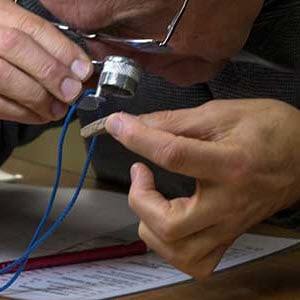
Many of these cultural artifacts wouldn't take survived if not for the intervention of passionate historians, archaeologists, anthropologists, tribal elders, and volunteers who've worked to map the sometimes murky waters of Native American history.
Concerted efforts by the European settlers of the Americas to devalue, erase, and re-ascertain the history of the Native American and Kickoff Nations tribes has obscured much of the true cultural history of these disparate and unique civilizations. Only recently take archaeologists and cultural anthropologists started to reveal some of the mysteries of the past previously hidden to us.
With any promise, hereafter generations of thinkers, historians, scientists, and volunteers will be motivated to continue to preserve and catalog the contributions of these ancient civilizations. As some of the most advanced and profound peoples to ever walk this globe, the Native American tribes have profoundly influenced the world civilisation, science, medicine, and art.
In this article, we'll focus specifically on the music, jewelry, and art of the Native American and First Nations tribes. The craftsmen, artisans, and performers of the ancient Get-go Peoples worked tirelessly to preserve their crafts post-obit the invasion of the white man of the Americas, and passed their skills direct down their line of descent.
Many living descendants of the great tribes keep to preserve the artistic abilities and cultural traditions of their ancestors with tireless passion, which allows the children of the future to continue to relish these amazing cultural relics which inspire images of another place and fourth dimension.
Native American Music

Music that stretches back into the American Indian past is even so widely enjoyed today by people all over the planet. Information technology remains 1 of the most popular forms of cultural music in the world, and has been credited with inspiring many spirited modernistic music genres, such equally New Wave and Ambient music styles (PediaPress, 2015, pp. 85-104).
Common instruments featured in Native American music include woodwinds, traditional percussion, vocals, and other cultural musical instruments. I'1000 a huge fan of the woodwinds and yous'll encounter this featured by my music selections in the video library.
The type of instruments used in the music volition vary depending on the style of the song and which tribe it is influenced by, and likewise may feature non-traditional instruments such every bit synthesizers, samplers, guitars, and any other variety of different instruments. This, of course, applies mostly to modernistic incarnations of pop Native American music, which is distinguished from the traditional cultural Native American music featured at pow-wows and traditional cultural events.
Music and the Spiritual Realm
While not all Native American tribes had stiff musical traditions, almost all of the tribes used music as a supplemental element in rituals and other cultural events. Some tribes accept a rich musical history, and music may have played a central element inside their tribal civilisation. In many of the Native American tribes, music historic certain aspects of life, such as the death or birth of a family member, the skill or life of a craftsman, the spiritual power of a local tribal elderberry or shaman, or a mythical tale of creation or interaction with the spirits and spirit globe (Heth, 2001, pp. 367-368).
Music in Native American traditions was often seen as the strongest link between the living and the dead, and almost tribes believed that music had the power to summon spirits, conjure powerful waking memories of revered tribal heroes and elders, and call upon the aid of gods and greater nature spirits to steer the tribe on a hard journeying (Heth, 2001, pp. 390-399).
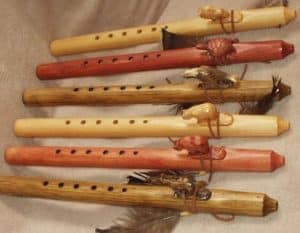
More often than not, there were three "types" of Native American instruments: stringed instruments, percussion instruments, and woodwind instruments (Warpaths to Peace Pipes, 1996). These musical instruments and musical styles can be heard today in the soundtracks to films and idiot box shows, such as the scores to western activeness movies and dramas (Harlee, 2004).
Because many of the cultural traditions of tribes were lost following the invasion of the Americas by European settlers and conquistadors, at that place is quite a scrap we do not know about the musical heritages of a significant cross-section of the great Amerindian and First Nations tribes. What we practise know is that music played a significant role in the day-to-day life of the average Native American tribesman. As peoples with a history strongly connected to oral communication and storytelling, music often acted as non simply a fashion to entertain and entrance the audition, but to reinforce cultural lessons and idioms and educate future generations of tribesmen with memorable lessons (Heth, 2001, pp. 340-341).
Native American musical traditions have influenced many modern genres of music. At that place are a large number of celebrated American Indian artists in the American land music genre who take helped re-define the modern country music industry with messages of promise, personal integrity, honor, compassion, and adherence to traditional values (Barnes, 2014).
Native American music shares many common traditions with Ancient music from Australia, with instruments similar the Bullroarer taking centerstage among a plethora of different assortments of cultural instruments (Warpaths to Peace Pipes, 1996).
Perhaps ane of the most well-recognized instruments originating from Native American tradition is the Apache fiddle, which is synthetic of sinew and other natural materials to create a distinctive and hands recognizable sound. Many artisans continue to construct these beautiful instruments today, using traditional methods to stay truthful to form (Kling, 2014).
American Indian Dance as Rooted in Music History

American Indian music was often accompanied by cultural dancing. The various war dances of the Native American tribes have become famed among historians for their power and ferocity, and have played a major role in the traditions of the majority of the First Nations tribes, especially during times of struggle and nifty change (Warpaths to Peace Pipes, 1996). A ceremony featuring colorful feathered outfits, thunderous state of war drums, jingling bells, formalism weaponry, and traditional chanting is oft featured at pw-wows and a variety of other cultural events (Wis-Ki-Ge-Amatyuk, 2009).
Music was i of the most widely-used ways among the diverse tribes to teach time to come generations of tribespeople the traditions, beliefs, and virtually important customs. Many tribes believe that musical skills were taught personally to the tribes by gods and spirits, and that music was a unique gift afforded to the American Indian tribes by the most revered spirits. Musicians were thus spiritually important to many Native American tribes, and were afforded similar levels of responsibility and authority to other mystics and elders (Heth, 2001, pp. 367-368).
The uniquely beautiful and haunting sound of the Native American flute is still used widely today in many musical creations. The innovative design of the Native American flute allows it to be played with relative ease compared to similar instruments from other cultures. The flute was designed to channel the breath of the performer efficiently in society to produce a tonally pleasing sound, which made it fairly easy to learn to play for new musicians amongst the tribes (Goss, 2015).
Native American Art
Native American art is derived from rich cultural traditions demonstrated across the Commencement Nations and American Indian tribes of the Americas. While art traditions and practices vary from tribe to tribe, there are certainly a number of common practices which link them all together. Like nigh Native American cultural crafts, Native American art is primarily concerned with the natural world, spirits and the afterlife, and the daily life of the American Indian tribespeople. Every bit such, animals and spirits oftentimes accept center stage in various Native American fine art pieces.
Native American art can include everything from pictographs and cave paintings to decorative shawls and pottery. Depending on the environment, history, and cultural values of the tribe, they may specialize in a certain form of art.
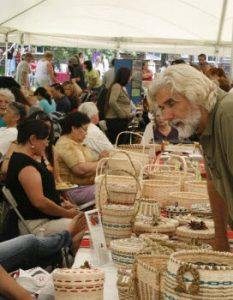
Basket weaving is a unique Native American cultural tradition practiced by a meaning number of tribes across the Americas. The baskets were oft either used in barter and trade to buy other goods, or were implemented in ceremonial and religious practices as a crucial attribute of the ritual. Basket construction methods varied depending upon the availability of materials, traditions, and blueprint preferences of any given Native American tribe. Pop methods included plaiting, twining, and coiling (Wilderness Higher, 2015). Plaiting, the most commonly-used method of handbasket construction across a broad variety of tribes, involves weaving together slats on the basket in an over-nether pattern. Twining, another common method employed by tribe craftsmen, involves threading the vertical and horizontal strands of the basket to create a stiff weave. Twining basket structure is splendid for the quick structure of survival baskets, and is easy to apply with the stiff branches of the willow and other types of semi-rigid plant material.
The chill tribes of Alaska and the northernmost regions of the Americas frequently create masks for the use in religious and cultural ceremonies. The masks may exist used for sacred or secular purposes, and are donned for the enjoyment of the tribe and to draw attention to certain performers and characters in cultural plays and ceremonies (Inuit Masks, 1995).
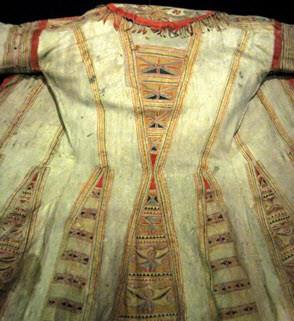
The subarctic tribes of the Americas held the mighty caribou in particular reverence, and their cultural goods often featured the caribou and other local animals. In particular, the hunters of the Innu covered their leggings, clothing, coats, quilts, and masks with images of the caribou, holding their casualty in distinguished reverence for providing sustenance for their tribe in the farthermost conditions of the coldest corners of Due north America (Heye, 2015).
The distinctive art style of the Northwest Coast/Pacific Northwest Amerindian tribe was normally featured on masks, totem poles, hats, necklaces, and other cultural objects of ceremonial and everyday importance. Red, teal, blackness, and white pigment is featured prominently on the art of tribes from this region (MacDonald, 1996). The Northwest Coast Indian art is some of the most popular and revered art of whatsoever drove of Native American tribes, and remains immensely revered even today for its dazzler. The art mode is said to focus on practical and realistic renderings of local wildlife and cultural symbols, with an emphasis on simplicity and ease of communication. The Kwakwaka'wakw and other Northwest tribes used their artistic abilities to aid brainwash future generations of their tribes using a diverse assortment of artistic traditions to communicate their ideas efficiently (Hawthorn, 1988).

The woodlands Native American art focused on the hunting and gathering traditions of the tribes residing due east of the Mississippi River. Earthen mounds and big burial sites helped preserve the unique fine art of these tribes for the appreciation of people from our age. These tribes are normally known by historians equally the "Mound Builders", for their tradition of constructing large burial mounds for their dead. As the dead of these tribes were commonly buried with their personal belongings, many cultural crafts have been discovered by archaeologists in the region, providing a good glimpse into the cultural traditions of these diverse tribes. Shells featured prominently in the fine art of the Mound Builders, as shellfish were a staple in the everyday life of the tribes (Canada's First Peoples, n.d.). Woodlands tribes frequently used shells to create beautiful beads and decorative elements in their habiliment and formalism or religious dress, or simply integrated visual depictions of shells and wildlife into the embroidery on their clothing.
The great plains tribes are some of the virtually revered and well-recognized Native American cultures today. The Sioux were among the almost famous of these tribes, with a rich history of artistic tradition. Examples of beautiful Sioux art can be found online at various destinations, just we recommend checking out museums in the area to see these beautiful pieces of fine art in person. Past purchasing museum tickets, you back up the efforts of historians and other specialists, which helps proceed these ancient cultures alive for future generations. Some neat examples of Sioux Native American art are found in their beaded goods. Common materials used in Sioux chaplet include vibrant drinking glass, deerskin, horns, animal bones, leather, and pigmented cloth (Sioux Fine art, north.d.).

The great basin Indian tribes have a number of their own culture products that remain fundamentally important to telling the story of the diverse Amerindian nations. Earlier the inflow of Columbus and other European settlers and invaders, these tribes created beautiful beaded collars and other worn decorations that helped greatly heighten their rituals and ceremonies (Great Basin: Beauty in Form and Function, 2015). Interestingly, the cultures of this area of the globe relied upon strongly-woven baskets over pottery, which resulted in tribes that trained tremendously talented weavers. This is a great instance of visually stunning Native American art.
Southwestern Native American tribes similar the Pueblo also created some truly stunning Native American art. Luckily, many of their most beautiful creations accept been preserved quite well for our enjoyment today. Pueblo pottery is regarded by archaeologists every bit 1 of the almost highly-adult Native American artforms (Pueblo Pottery, 2015). With the culture of the Pueblo tribes peaking in the 1050-1300 Ad period, the traditional methods used to make pottery and other types of like Native American art today are still identical to the original methods employed by craftsmen who lived centuries ago. Craftsmen keep to continue the traditions alive to show united states of america how these vibrant peoples lived.
Native American Jewelry

Native American jewelry was coveted by the European invaders for its beauty and for the often valuable minerals it used in its structure. Unfortunately, many of these cultural artifacts have been lost to time, but a few mighty examples stand up as testament to the creative beauty of the Native American tribes.
Tribes like the Pueblo proceed to use traditional methods of jewelry creation, integrating local elements into stunning pieces of artwork. These pieces of art adorn the necks, wrists, and fingers of many tourists from abroad who visit the American southwest. They are widely available for purchase on different online marketplaces (Native American Indian Jewelry, 2015).
Native American jewelry makers were frequently afforded special reverence and titles for their skill in their merchandise. Without the development of written language and a strong oral tradition, the Native American tribes relied heavily upon jewelry and other adornments to communicate identities, ideas, and data (Dubin, 2003). Common elements contained inside many Native American jewelry pieces included nickel silver and minerals found from local rivers and streams (Caesar, 1984).

Silver and other elements were hammered into shape to draw animals, geological elements, revered mythical and spiritual figures, and other important symbols to Native American tribes (Dubin, 2003, pp. 284-291). Skillful craftsmen fashioned beads, animate being os, turquoise, pieces of pottery craft, teeth, hair and fur, and a variety of other unlike natural and manmade elements into brilliant pieces of jewelry commonly worn by of import people within the tribes.
Contemporary Navajo jewelry, which differs very little from the original cultural crafts of the Navajo tribe, is an case of truly beautiful Native American jewelry. Early Navajo jewelry includes a variety of unlike vibrant belt fasteners and cords, bracelets, silver adornments, and anklets (Navajo Jewelry, 2015).
Because the Native American tribes did not strip mine the earth of minerals in the European mode, in that location was not an affluence of gold or other elements commonly establish in the jewelry of Europe, the Near-east, and of Arabia. About elements used in Native American jewelry were gathered from nearby sites, and included softer alloys plant in rivers, caves, and natural reservoirs.
Because of the beauty and rarity of aureate (and the lack of gold on surface-level natural sites), it was rare among Native American creations and was specially valued. Tribal chiefs, elders, and spiritual leaders near commonly possessed gold jewelry if anyone in the tribe did at all.
Modern Native American Art
Thankfully, many institutions are working tirelessly to preserve the artistic traditions of the various Native American tribes. The United states, Canada, Mexico, and Central and Southward American governments accept granted significant corporeality of funds to the preservation of cultural traditions and arts. The incentive for governments to protect these ancient and sacred cultures is that they bulldoze up tourism and international interest, since then many people experience a deep connection to these aboriginal cultures. It's more important than ever that governments continue to protect these cultures in tumultuous times when unexpected international incidents and political change occur at an alarming rate.
With the assistance of volunteers from a variety of different institutions, there is hope that Native American art, Native American jewelry, and Native American music will exist enjoyed by many hereafter generations to come.
This article is an endeavor to requite a small overview of the cute cultural craftwork fashioned by these aboriginal cultures, just it is by no means comprehensive. Nosotros've barely scratched the surface of the multitudes of different Native American cultures. We recommend looking further into your favorite Native American tribes to find out more than about their cultural history.
Thankfully, the Internet has opened upwardly our minds to a earth of knowledge and principal sources. It is easier than ever to track down historical records and testimony, with and then much information archived on various online websites. Check out our Native American resources to discover more about the Native American tribes, and benefit from the hard piece of work and perseverance of passionate researches who've helped map the aboriginal world and souvenir us with the resource to know more about these beautiful and diverse cultures.
References
Barnes, T. (2014, December 10). Native Americans Are Writing the Most Powerful Country Music Today. Mic Magazine.
Caesar, B. (1984). Pawnee-Sac and Fox. Oklahoma Metropolis, Oklahoma, U.s.a. of America.
Canada'due south Start Peoples. (n.d.). Eastern Woodland Hunters. Retrieved from Canada's First Peoples: http://firstpeoplesofcanada.com/fp_groups/fp_wh5.html
Dubin, L. S. (2003). North American Indian Jewelry and Adornment: From Prehistory to Present, Concise Edition. Harry N. Abrams.
Goss, C. (2015, December vi). Anatomy of the Native American Flute. Retrieved from Flutopedia: http://flutopedia.com/beefcake.htm
Great Basin: Dazzler in Course and Function. (2015). Retrieved from Autry: https://theautry.org/american-indian-arts-marketplace/smashing-basin
Harlee, J. (2004). Native American Music in Flick. Native American Cultural Press.
Hawthorn, A. (1988). Kwakiutl Art: Seattle. University of Washington Press.
Heth, C. (2001). The Garland Encylopedia of Globe Music. London: Routledge.
Heye, G. (2015). The Arctic and Subarctic. Retrieved from NMAI: https://americanindian.si.edu/exhibitions/infinityofnations/chill-subarctic.html
Inuit Masks. (1995). Retrieved from Indians: http://www.indians.org/articles/inuit-masks.html
Kling, Grand. (2014, February 21). Anthony Belvado and the Apache Fiddle Tradition. Phoenix, Arizona, United states.
MacDonald, G. (1996). Haida Art: Seattle. University of Washington Printing, 211-212.
Navajo Jewelry. (2015). Retrieved from Twinrocks.
PediaPress. (2015). Ambient Music. New York: PediaPress.
Pueblo Pottery. (2015). Retrieved from Britannica.
Sioux Art. (north.d.). Retrieved from Indians: http://world wide web.indians.org/articles/sioux-art.html
Warpaths to Peace Pipes. (1996). American Indian Music. Retrieved from Warpaths to Peace Pipes.
Wilderness College. (2015). Native American Basket Weaving. Retrieved from Wilderness College.
Wis-Ki-Ge-Amatyuk, G. (2009, Dec twenty). https://www.youtube.com/lookout man?v=nA0bTp677gk. Retrieved from YouTube: https://www.youtube.com/watch?five=nA0bTp677gk
Source: https://americanindiancoc.org/music-arts-jewelry/
0 Response to "What Are the Most Common Arts and Crafts Sioux Nations"
Post a Comment